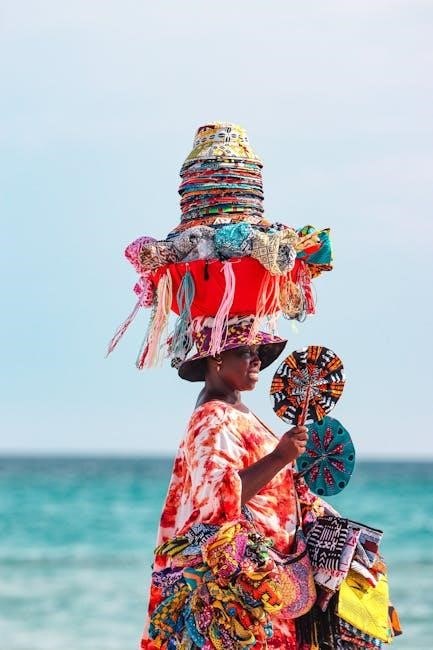
Letra del Año 2024: An Overview
The “Letra del Año” (Letter of the Year) is a prophetic oracle from Ifá, unveiled annually by the Yoruba Cultural Association of Cuba. It serves as a guide for the upcoming year, offering predictions, recommendations, and warnings relevant to both Cuba and the world.

Key Predictions of Ifá for 2024
The Ifá predictions for 2024, as revealed in the “Letra del Año,” highlight several key areas of concern and opportunity. One significant prediction emphasizes the importance of protection against false testimonies, urging individuals to be cautious and discerning in their interactions and legal matters. Additionally, Ifá stresses the need to prioritize the well-being and care of children, ensuring their safety and development.
Furthermore, the predictions encourage individuals to identify and cultivate their unique potentials, utilizing their talents and abilities for the greater good. The “Letra del Año” also forecasts a potential rise in specific health issues, including diseases of the lower abdomen, genetic disorders like Down syndrome, neurological and cerebrovascular conditions, and skin ailments. Ifá advises increased vigilance and preventative measures in these areas.
Socially, the predictions caution against the dangers of alcohol and drug abuse, particularly among young people, advocating for increased awareness and prevention efforts. Discretion in revealing secrets is also advised, emphasizing the importance of trust and confidentiality. Finally, travelers within the country are urged to take precautions to safeguard their belongings, guarding against potential theft or loss.
Ruling Sign: Irete Otura (Irete Suka)
The ruling sign for the year 2024, according to the “Letra del Año,” is Irete Otura, also known as Irete Suka. This sign carries significant meaning and implications for the year ahead, providing guidance and insights into the challenges and opportunities that may arise. Irete Otura emphasizes the importance of maintaining a strong defense against false testimonies and accusations, urging individuals to be vigilant and protect themselves from potential harm.
The sign also highlights the need for careful attention to children, emphasizing their well-being and protection. It suggests that nurturing and guiding the younger generation will be crucial in 2024. Furthermore, Irete Otura encourages individuals to identify and develop their inherent potential, using their unique talents and abilities to contribute positively to society.
This sign serves as a reminder to cultivate inner strength and resilience, enabling individuals to overcome obstacles and navigate the complexities of the year with wisdom and fortitude. Irete Otura underscores the value of integrity, honesty, and ethical conduct in all aspects of life, promoting harmonious relationships and a just society.

Regent Deities: Elebara and Oyá
For the year 2024, the regent deities, as revealed in the “Letra del Año,” are Elebara and Oyá; Elebara, also known as Elegua, is a powerful Orisha who stands at the crossroads of life, opening and closing paths and opportunities. He is a messenger deity, facilitating communication between the human and spiritual realms. His presence signifies the importance of making wise choices and being open to new beginnings.
Oyá, on the other hand, is a fierce and dynamic Orisha associated with winds, storms, and the realm of the dead. She is a powerful force of transformation, capable of clearing away obstacles and bringing about necessary change. Oyá’s presence suggests a year of significant shifts and the need to embrace adaptability and resilience.
Together, Elebara and Oyá represent a balance of opportunity and change. Elebara’s guidance helps navigate new paths, while Oyá’s transformative energy clears the way for progress. This pairing indicates a year that requires both careful consideration and the courage to embrace the winds of change. Their combined influence suggests a period of dynamic possibilities.
Association Cultural Yoruba de Cuba Announcement
The Association Cultural Yoruba de Cuba plays a pivotal role in the annual unveiling of the “Letra del Año.” This esteemed organization, deeply rooted in Yoruba traditions, gathers its assembly of Ifá priests to conduct the sacred divination ceremony. Their collective wisdom and spiritual insight culminate in the interpretation of the year’s prophetic message.
The announcement of the “Letra del Año” by the Association Cultural Yoruba de Cuba is a highly anticipated event, not only for practitioners of Santería but also for the wider Cuban community and individuals across the globe seeking guidance and understanding. The Association’s credibility and dedication to preserving Yoruba heritage lend significant weight to the pronouncements made.
Each year, the Association meticulously prepares for this crucial event, ensuring the accuracy and integrity of the divination process. Their commitment to tradition and spiritual practice ensures that the “Letra del Año” remains a valuable resource for those seeking insight into the challenges and opportunities that lie ahead. The announcement signifies a moment of reflection and anticipation.
Meaning of Iré Buyoko Lowo Asojano
The Lucumi phrase “Iré Buyoko Lowo Asojano” translates to “a blessing of stability through Asojano.” This profound message, central to the Letra del Año 2024, speaks to the potential for achieving a state of well-being and groundedness with the assistance of the Orisha Asojano. Asojano is associated with healing and overcoming adversity.
The “Iré Buyoko Lowo Asojano” suggests that stability will be achieved in 2024 by connecting with the energy of Asojano. It indicates that seeking Asojano’s assistance is a path to finding inner peace and security.
The interpretation highlights the significance of turning to spiritual guidance during times of uncertainty. It acknowledges that challenges may arise, but emphasizes that with the help of Asojano, individuals can find their footing and build a solid foundation. This message inspires trust in the divine.
The Orisha Asojano offers a way to overcome obstacles and find a sense of belonging. “Iré Buyoko Lowo Asojano” serves as a beacon of hope, reminding believers that even amidst the storms of life, stability and blessings are attainable through faith and devotion.
Ebbo (Sacrifices) Recommended by Ifá
Ifá prescribes specific “ebbo” (sacrifices or offerings) to mitigate negative influences and attract positive energies for the year. These rituals vary for Ifá priests and Santeros, involving symbolic items and actions to appease the Orishas and ensure balance.
Ebbo ni Ifá Details
The “Ebbo ni Ifá,” specifically designed for Ifá priests, constitutes a detailed ritual aimed at harmonizing with the energies of the year. According to the Letra del Año 2024, this Ebbo involves specific items, each carrying symbolic weight. The prescribed offering includes an Akukó (rooster), accompanied by body measurements of the individual seeking guidance.
Furthermore, the Ebbo calls for a crown, a purple cloth, a stone sourced from a hill, and a white cloth. These elements represent authority, spirituality, grounding, and purity, respectively. Water from the sea and soil from the four corners of a location are included to draw upon the power of nature.
The Ebbo also requires a collection of provisions, including mixed grains, smoked fish, smoked jutia (a type of rodent), and toasted corn. These represent sustenance and prosperity; All these items are offered with a specific “Derecho,” a payment that accompanies the ritual. This comprehensive Ebbo seeks to align the Ifá priests with the positive forces indicated in the Letra del Año 2024.
Ebbo for Santeros Details
The “Ebbo for Santeros” outlines a specific cleansing ritual tailored for initiates within the Santería tradition, as revealed in the Letra del Año 2024; This Ebbo is designed to mitigate negative influences and usher in positive energies for the year ahead. The prescribed offering includes a pollo (chicken), symbolizing sacrifice and renewal.
Central to the Ebbo is a crown, representing spiritual authority and connection to the Orishas. A stone collected from each of the four corners of the house is also required. These stones symbolize protection, stability, and the warding off of negative energies from all directions.
Three dolls are included in the Ebbo, representing the need to address potential challenges related to relationships or personal well-being. Smoked fish, smoked jutia (a type of rodent), and toasted corn are also required. These represent sustenance and prosperity; The ritual entails a specific “Derecho,” a monetary offering accompanying the prescribed items. This Ebbo seeks to guide Santeros toward a path of balance and prosperity.
Health Concerns Highlighted in the Letra del Año 2024
The Letra del Año 2024 casts a spotlight on specific health concerns anticipated to be prevalent during the year, urging preventative measures and heightened awareness. A significant emphasis is placed on diseases affecting the lower abdomen, indicating potential issues related to reproductive health, digestive disorders, or urinary tract ailments.
Furthermore, the oracle highlights the risk of genetic disorders, specifically mentioning conditions such as Down syndrome. This suggests a need for increased genetic counseling and prenatal care. Neurological and cerebrovascular diseases are also identified as areas of concern, pointing towards potential increases in strokes, dementia, or other nervous system disorders.
Finally, the Letra del Año 2024 signals a heightened prevalence of skin diseases. This could encompass a wide range of conditions, from infections and allergies to more chronic dermatological issues. The forecast serves as a call to action, encouraging individuals to prioritize their well-being through proactive healthcare practices.

Social Recommendations from Ifá
The Letra del Año 2024 provides crucial social recommendations aimed at fostering a more harmonious and prosperous society. Ifá strongly advises increasing preventative efforts regarding alcohol and drug consumption, particularly among young people. This highlights a growing concern about substance abuse and its detrimental effects on the youth and calls for targeted interventions and educational programs.
Discretion in revealing secrets is also emphasized. This suggests that maintaining confidentiality and avoiding gossip are vital for building trust and preventing conflicts within communities. Furthermore, the recommendations caution individuals to take precautions with their belongings during domestic travel, implying a potential rise in theft or security concerns within the country.
By adhering to these social recommendations, individuals can contribute to a more responsible, secure, and harmonious environment, fostering stronger community bonds and promoting overall well-being. The recommendations act as a guide to navigate the complexities of the year.

Refranes (Sayings) Associated with the Ruling Sign
The ruling sign of the Letra del Año 2024, Irete Otura, comes with several associated “refranes” or sayings that offer guidance and wisdom for navigating the year. These refranes encapsulate key themes and provide a framework for understanding the challenges and opportunities that may arise.
One prominent refran is: “El que nació para cabeza no se queda en la cola,” meaning “He who was born to be a head does not stay in the tail.” This implies that individuals destined for greater achievements should not be held back, but rather encouraged to pursue their potential. It emphasizes the importance of perseverance, self-belief, and striving for excellence, even in the face of adversity. This refran suggests that those with ambition and a strong “Iwa Pele” will achieve greater success.
These sayings provide valuable insights into the spiritual and practical aspects of life, offering guidance for personal growth, relationships, and decision-making throughout the year.
Location of the Ceremony
The annual ceremony for the “Letra del Año” 2024, a significant event for the Yoruba religious community, took place at the headquarters of the Asociación Cultural Yoruba de Cuba. This institution serves as the central hub for Yoruba traditions and practices in Cuba, making it the natural setting for such an important ritual.
Specifically, the ceremony was held at the Asociación Cultural Yoruba de Cuba’s building, located at Prado 615, between Monte and Dragones, in the Municipality of La Habana Vieja (Old Havana), Havana, Cuba. This location holds historical and cultural significance for the Yoruba community in Cuba, solidifying its role as the traditional site for this annual divination.
The gathering of Ifá priests at this location underscores the importance of community and tradition in preserving and transmitting Yoruba religious knowledge. The location itself becomes a sacred space during the ceremony, imbued with the spiritual energy and ancestral wisdom of the Yoruba faith.
Importance of Protection Against False Testimony
The “Letra del Año” 2024, with its ruling sign Irete Otura (Irete Suka), strongly emphasizes the crucial need for protection against false testimony. This highlights a prevailing concern about potential deceit, misrepresentation, and unjust accusations that could significantly impact individuals and communities.
In a world where misinformation and slander can spread rapidly, the “Letra del Año” serves as a timely reminder to be vigilant against falsehoods and to actively defend oneself and others from unfair allegations. This protection extends beyond legal contexts, encompassing personal relationships, professional environments, and broader social interactions.
The emphasis on guarding against false testimony underscores the importance of truth, integrity, and ethical conduct in all aspects of life. It calls for individuals to be discerning in their judgments, to seek accurate information, and to stand up against those who spread lies or engage in deceptive practices. By prioritizing truth and justice, individuals can contribute to a more harmonious and equitable society.

